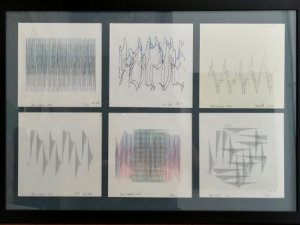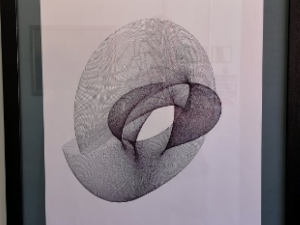Jack Tait
The Drum/Plotter Machine (1972)
A drum X:Y plotter design with integral programming. It was capable of a large variety of programmes, having three different sequence generators, an auto-reverse facility, a pen lift, a differential drive to the drum to allow two different simultaneous inputs and lastly an automatic variable voltage potentiometer. It preceded the digital machine by some years. Its success was one of the reasons to abandon the slow HP 9125A digital machine and revert to analogue.
The set of images shows the variety of drawings produced. The square format enabled drawings to be overlapped using different colours and where a 90-degree move was possible. This machine led to a number of other machines and helped extend the development of ideas. Unfortunately, it was dismantled, but as it differed from all subsequent machines it is hoped to rebuild it.
Deformed Circle Program (1981)
The motivation for this set of drawings was to programme a 1969 vintage Hewlett Packard 9125A calculator-plotter to draw circles and deform them by altering the circle drawing algorithm, employing a random element to shift the degree data in the formula. Placing a number of circles inside each other allowed the spaces created to be exploited when the images were scanned and colour added in Adobe Photoshop. See attached jpeg images.
The programming was challenging. The 9125A had only had 4K of memory; all the programming was in Octal. ROM mathematical functions generated the drawings and created the quasi-random input. The plotter was painfully slow, drawing 1/10th inch per second. Drawings took a long time to complete.
As work was done in 1981; (no Macs then!) only the HP rig was available. The alternative was the college mainframe and learning Fortran or Pascal. The slowness of the 9125A encouraged the development of the analogue approach. Designing the machines and programmers meant not relying on the limited digital route.
The Hommage to Henry Machine (2016)
This is the 'Hommage to Henry Machine' developed with Elaine O'Hanrahan, Desmond Paul Henry's daughter. He left no detailed drawings of the three versions of his drawing rigs. The mechanical functions, available from the Sperry computer, had to be analysed to establish which were most likely to generate the character of his work. Fortunately, the analysis worked out. The first HHM drawings were approved by Elaine.
This reverse engineering took the author's work down a different path. Mechanical embellishments were added to the first prototype. These were:- an elliptical platen instead of a circular turntable, a sun and planet gearing replaced plain cranks on the X-axis and later on the Y. The first machine relied upon the instability of two matched D.C. motors as was the case in the Sperry computer. Later, a differential gearbox was substituted to control the X:Y relationship with more precision. A pen-lift device was also added to generate a broken line effect, now the main feature of recent research into 'near chaos'. The secondary patterns thus generated are an important feature. The image on display is typical of the recent drawing. The earlier example shows the difference produced by the embellishments. The current machine has become wholly different from the first reverse engineered machine.
Short CV
1952-55 RAF Three years regular service in the RAF not only taught photographic skills but work in a Radar Research unit led to ideas being developed many years later re. drawing with light. The radar section had a machine capable of scanning black and white images and converting them into colour transparencies.
1955-8 Guildford School of Photography. Three years at the famous Guildford School of Photography led by Ifor and Joy Thomas built on the RAF experience and gave a thorough grounding in the Bauhaus approach to creative work. Was lucky to be the only student ever to win the prize for the best year's work in both the first and third year. Third-year studies were paid for by being allowed to do advertising photography and writing for the photographic press.
1958-60 Head-hunted from Guilford to introduce photography to the School of Graphic Design, Manchester Regional College of Art. Manchester, with Leicester, were the first colleges to incorporate photography into art education. Studied using photographs in silkscreen, litho and etching processes.
1960-61 Associated Press Left education to do freelance press photography.
1961-64 Derby College of Art Appointed to head of photography. Built up the school from virtually nothing to one having a reputation as one of the leading creative establishments of the '60s. Derby was the first school of photography to develop the use of giant enlargements - up to six feet - and to present these in a toned and hand coloured state. Exhibited at the Whitechapel art gallery.
1964 Kodak Colour Scholarship This was a competitive scholarship to work with Eastman Kodak in Rochester studying colour photography. Work from the UK exhibition drew favourable comments from Cecil Beaton.
1965-75 Manchester Polytechnic From the post at Derby was 'headhunted' to start the new photography course at Manchester, which was to embrace both creative and scientific work. Given a completely free hand, with arguably the largest and best-funded school of photography in Europe, a diverse and talented group of staff was appointed. Owing to continued exhibitions and press articles the school soon achieved a first class reputation and drew students from both the UK and abroad.
During this time books were published: Programme Learning in Photography - Stillit books, joint author, 'Beyond Photography' - Focal Press – sole author, 'The Illustrated Dictionary of Photography', Fountain Press, joint author. This initiated by the author won the Time Life award for joint best buy in 1973.
1965-75 Chief photographic consultant to Which Magazine where the first system for testing colour film and cameras was established and became the benchmark for all subsequent tests. This association continued for 10 years and involved a number of trips to the continent. CNAA M. Phil in colour measurement entitled 'The maintenance of Neutral Balance'.
1975-76 Singapore Seeking new challenges, a freelance business was begun in the Far East. A wide variety of work including fashion, still life and vehicles/ships included proofreading and designing the signing system for Singapore Zoo. Work for Shell produced pictures for a prestige book on Brunei involving portraits of the Sultan and his family. Illness caused a return to the UK.
1980-1989 Newport. Appointed Head of Graphic Design at The Gwent College of Higher Education to run the only B. A. Hons Graphic Design course in Wales. Introduced new technology and modernised a moribund course bringing it into the '80s. The main task was to introduce the first Apple Macintosh computers to the college together with a Berthold computer typesetting facility. The course flourished and the students got jobs in the design industry
1987–2003 Freelance Architectural Photography. Architectural photography practice included the design and production of super wide-angle cameras. Prestige architectural jobs included the 1999 Sydney Olympics buildings (six-page spreads given in both FX Magazine and the leading architectural weekly Building Design. The MOD brochure at Filton Bristol was a photography commission celebrating their opening and was presented to HRH The Queen.
2003-Present Taitographs Following retirement from photography concentrated drawing machine research leading to a PhD, awarded by Manchester Metropolitan in 2011. All machines and programmers from this were acquired by the Science Museum. Present work includes designing further machines providing material for published papers on the theme of 'Near chaos' in analogue drawing machines.



